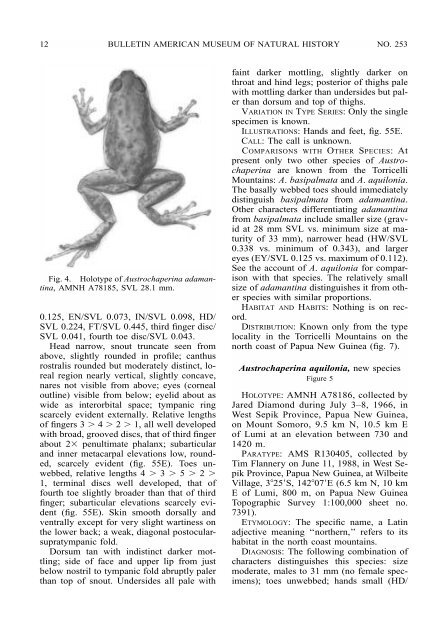SPHENOPHRYNE - American Museum of Natural History
SPHENOPHRYNE - American Museum of Natural History
SPHENOPHRYNE - American Museum of Natural History
You also want an ePaper? Increase the reach of your titles
YUMPU automatically turns print PDFs into web optimized ePapers that Google loves.
12 BULLETIN AMERICAN MUSEUM OF NATURAL HISTORY NO. 253<br />
Fig. 4. Holotype <strong>of</strong> Austrochaperina adamantina,<br />
AMNH A78185, SVL 28.1 mm.<br />
0.125, EN/SVL 0.073, IN/SVL 0.098, HD/<br />
SVL 0.224, FT/SVL 0.445, third finger disc/<br />
SVL 0.041, fourth toe disc/SVL 0.043.<br />
Head narrow, snout truncate seen from<br />
above, slightly rounded in pr<strong>of</strong>ile; canthus<br />
rostralis rounded but moderately distinct, loreal<br />
region nearly vertical, slightly concave,<br />
nares not visible from above; eyes (corneal<br />
outline) visible from below; eyelid about as<br />
wide as interorbital space; tympanic ring<br />
scarcely evident externally. Relative lengths<br />
<strong>of</strong> fingers 3 4 2 1, all well developed<br />
with broad, grooved discs, that <strong>of</strong> third finger<br />
about 2 penultimate phalanx; subarticular<br />
and inner metacarpal elevations low, rounded,<br />
scarcely evident (fig. 55E). Toes unwebbed,<br />
relative lengths 4 3 5 2 <br />
1, terminal discs well developed, that <strong>of</strong><br />
fourth toe slightly broader than that <strong>of</strong> third<br />
finger; subarticular elevations scarcely evident<br />
(fig. 55E). Skin smooth dorsally and<br />
ventrally except for very slight wartiness on<br />
the lower back; a weak, diagonal postocularsupratympanic<br />
fold.<br />
Dorsum tan with indistinct darker mottling;<br />
side <strong>of</strong> face and upper lip from just<br />
below nostril to tympanic fold abruptly paler<br />
than top <strong>of</strong> snout. Undersides all pale with<br />
faint darker mottling, slightly darker on<br />
throat and hind legs; posterior <strong>of</strong> thighs pale<br />
with mottling darker than undersides but paler<br />
than dorsum and top <strong>of</strong> thighs.<br />
VARIATION IN TYPE SERIES: Only the single<br />
specimen is known.<br />
ILLUSTRATIONS: Hands and feet, fig. 55E.<br />
CALL: The call is unknown.<br />
COMPARISONS WITH OTHER SPECIES: At<br />
present only two other species <strong>of</strong> Austrochaperina<br />
are known from the Torricelli<br />
Mountains: A. basipalmata and A. aquilonia.<br />
The basally webbed toes should immediately<br />
distinguish basipalmata from adamantina.<br />
Other characters differentiating adamantina<br />
from basipalmata include smaller size (gravid<br />
at 28 mm SVL vs. minimum size at maturity<br />
<strong>of</strong> 33 mm), narrower head (HW/SVL<br />
0.338 vs. minimum <strong>of</strong> 0.343), and larger<br />
eyes (EY/SVL 0.125 vs. maximum <strong>of</strong> 0.112).<br />
See the account <strong>of</strong> A. aquilonia for comparison<br />
with that species. The relatively small<br />
size <strong>of</strong> adamantina distinguishes it from other<br />
species with similar proportions.<br />
HABITAT AND HABITS: Nothing is on record.<br />
DISTRIBUTION: Known only from the type<br />
locality in the Torricelli Mountains on the<br />
north coast <strong>of</strong> Papua New Guinea (fig. 7).<br />
Austrochaperina aquilonia, new species<br />
Figure 5<br />
HOLOTYPE: AMNH A78186, collected by<br />
Jared Diamond during July 3–8, 1966, in<br />
West Sepik Province, Papua New Guinea,<br />
on Mount Somoro, 9.5 km N, 10.5 km E<br />
<strong>of</strong> Lumi at an elevation between 730 and<br />
1420 m.<br />
PARATYPE: AMS R130405, collected by<br />
Tim Flannery on June 11, 1988, in West Sepik<br />
Province, Papua New Guinea, at Wilbeite<br />
Village, 325S, 14207E (6.5 km N, 10 km<br />
E <strong>of</strong> Lumi, 800 m, on Papua New Guinea<br />
Topographic Survey 1:100,000 sheet no.<br />
7391).<br />
ETYMOLOGY: The specific name, a Latin<br />
adjective meaning ‘‘northern,’’ refers to its<br />
habitat in the north coast mountains.<br />
DIAGNOSIS: The following combination <strong>of</strong><br />
characters distinguishes this species: size<br />
moderate, males to 31 mm (no female specimens);<br />
toes unwebbed; hands small (HD/
















